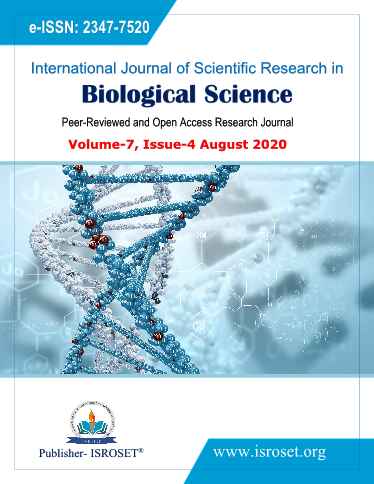Utilization of Wild Edible Plants in Thiruppuvanam Region of Sivagangai District in Tamil Nadu, Southern India
Keywords:
Wild edible plants, Thiruppuvanam region, Sivagangai district, Tamil NaduAbstract
Wild edible plants have sustained human populations in each of the inhabited continents. In India, the parts collected from the wild edible plants play a significant role in the food and nutrient security of rural and tribal people. Hence, the present study focused to document the traditional knowledge of wild edible plants utilized by the rural people dwelling in various localities of Thiruppuvanam region. By this study, the different parts of 40 plants have been recorded to be used for edible purposes. Out of 40 species recorded, 39 species belongs to angiosperm and 1 to pteridophyte. Research attention is needed to increase awareness on the use and management of wild edible plants for their conservation. The nutritional values of these plants should also be evaluated.
References
H.B. Singh, R.K. Arora, “Wild Edible Plants of India”, Indian Council of Agricultural Research (ICAR), New Delhi, 1978.
T.S. Jasmine, S. Jeeva, G.L. Febreena, B.P. Mishra, R.C. Laloo, “Wild edible plants of Meghalaya, North- East India”, Natural Products Radiance, Vol. 6, pp. 410-426, 2007.
V. Arinathan, V.R. Mohan, Maruthupandian, “Wild edible unripe fruits used by the Paliyars of Western Ghats, Tamil Nadu”, Journal of Non-Timber Forest Products, Vol. 18, pp. 149-152, 2011.
R. Sasi, A. Rajendran, M. Maharajan, “Wild edible plant diversity of Kotagiri hills- a part of Nilgiri Biosphere Reserve, Southern India”, Journal Research in Biology, Vol. 2, pp. 80-87, 2011.
L. Rasingam, “Ethnobotanical studies on the wild edible plants of Irula tribes of PillurValley, Coimbatore district, Tamil Nadu, India”, Asian Pacific Journal of Tropical Biomedicine, Vol. 2, pp. S1493-S1497, 2012.
V.S. Ramachandran, C.U. Vani, “Knowledge and uses of wild edible plants by Paniyas and Kurumbas of Western Nilgiris, Tamil Nadu”, Indian Journal Natural Products and Resources, Vol. 4, pp. 412-418, 2013.
A. Venkatachalapathi, S. Paulsamy, “The wild RET edible plants consumed by the Irula tribals of Walayar valley, Southern Western Ghats of India”. Journal of Ayurvedic and Herbal Medicine, Vol. 3, Issue 4, pp. 205-209, 2017.
K. Aadhan, S.P. Anand, “Utilization of wild edible plants by Paliyar’s tribe of Sadhuragiri hills, Tamil Nadu, India”, International Journal Recent Scientific Research, Vol. 9, Issue 5, pp. 27090-27096, 2018.
G. Venkatesan, “Traditional wild edible plants from Cauvery Delta Region of Tamil Nadu, India”, Journal of Emerging Technologies and Innovative Research, Vol. 6, Issue 3, pp. 618-627, 2019.
K.M. Matthew, “An Excursion Flora of Central Tamil Nadu”, Oxford and IBH Publishing Co. Pvt. Ltd, New Delhi, 1991.
APG IV, “An update of the Angiosperm Phylogeny Group classification for the orders and families of flowering plants”, Botanical Journal of the Linnean Society, Vol. 18, Issue 1, pp. 1-20, 2016.
V.S. Ramachandran, “Wild edible plants of the Anamalis, Coimbatore district, Western Ghats, Tamil Nadu”, Indian Journal of Traditional Knowledge, Vol. 6, Issue 1, pp. 173-176, 2007.
S. Shanmugam, G. Muthuraja, M. Dhanasekaran, M. Annadurai, S. Gobinathan, “Ethnobotanical study on the plants used as leafy vegetables by Paliyar tribes of Pachalur in Dindigul district of Tamil Nadu, India”, Life Sciences Leaflets, Vol. 4, pp. 44-47, 2012.
V.S. Ramachandran, C. Udhayavani, “Knowledge and uses of wild edible plants by Paniyas and Kurumba of Western Nilgiris, Tamil Nadu” Indian Journal of Natural Products and Resources, Vol. 4, Issue 4, pp. 412-418, 2013.
R. Sathyavathi, K. Janardhanan, “Wild edible fruits used by Badagas of Nilgiri district, Western Ghats, Tamil Nadu, India”, Journal of Medicinal Plants Research, Vol. 8, Issue 1, pp. 128-132, 2014.
IUCN (International Union for Conservation of Nature), “The Red List of Threatened Species (version 3.1)”, www.iucnredlist.org, accessed on 17 October, 2020.
A. Jomy, “Wild edible plants used by the tribes of Periyar Tiger reserve Kerala, South India”, Journal of Economic Taxonomic Botany, Vol. 29, Issue 1, pp. 273-231, 2005.
S. Binu, “Wild edible plants used by tribals in Pathanamthitta district, Kerala”, Indian Journal of Traditional Knowledge, Vol. 9, Issue 2, pp. 309-312, 2010.
A. Nazarudeen, “Nutritional composition of some lesser known fruits used by the ethnic communities of local folks of Kerala”, Indian Journal of Traditional Knowledge, Vol. 9, Issue 2, pp. 398-402, 2010.
M.K. Ratheesh Narayanan, N. Anilkumar, V. Balakrishnan, M. Sivadasan, H. Ahmed Alfarhan, A.A. Alatar, “Wild edible plants used by the Kattunaikka, Paniya and Kuruma tribes of Wayanad district, Kerala, India”, Journal of Medicinal Plants Research, Vol. 5, Issue 5, pp. 3520-3529, 2011.
M.S. Ali-shtayeh, R.M. Jamous, J.H. Al-Shafie, F.A. Elgharabah Kherfan, K.H. Qarariah, I.S. Khdair, “Traditional knowledge of wild edible plants used in Palestine: a comparative study”, Journal of Ethnobiology and Ethnomedicine, Vol. 4, pp. 13, 2008.
S. Shanmugam, K. Manikandan, K. Rajendran, “Ethnomedicinal survey of medicinal plants used for the treatment of diabetes and jaundice among the villagers of Sivagangai district, Tamil Nadu”, Ethnobotanical Leaflets, Vol. 13, pp. 186-193, 2009.
S. Shanmugam, M. Kalaiselvan, P. Selvakumar, K. Suresh, K. Rajendran, “Ethnomedicinal plants used to cure diarrhoea and dysentery in Sivagangai district of Tamil Nadu, India”, International Journal of Research in Ayurveda and Pharmacy, Vol. 2, Issue 5, pp. 991-994, 2011.
S. Shanmugam, K. Rajendran, K. Suresh, “Traditional uses of medicinal plants among the rural people in Sivagangai district of Tamil Nadu, Southern India”, Asian Pacific Journal of Tropical Biomedicine, Special Issue, pp. S429-S434, 2012.
S. Shanmugam, S. Balamurugan, P. Pandiselvam, K. Rajendran, “Medicinal plants used by the people of Thiruppuvanam and its surrounding areas of Sivagangai district in Tamil Nadu, Southern India”, Journal of Basic and Applied Biology, Vol. 6, pp. 39-45, 2012.
Downloads
Published
How to Cite
Issue
Section
License

This work is licensed under a Creative Commons Attribution 4.0 International License.
Authors contributing to this journal agree to publish their articles under the Creative Commons Attribution 4.0 International License, allowing third parties to share their work (copy, distribute, transmit) and to adapt it, under the condition that the authors are given credit and that in the event of reuse or distribution, the terms of this license are made clear.







